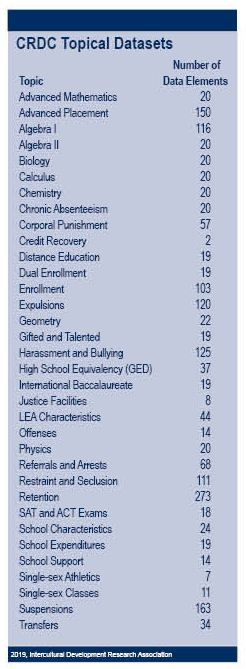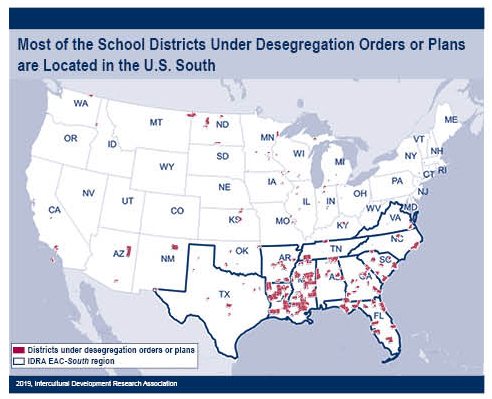• by Bricio Vasquez, Ph.D. • IDRA Newsletter • January 2019 •


The CRDC data are administered by the Office for Civil Rights (OCR) under the U.S. Department of Education. The data contain information from educational organizations that receive federal funding, including public school districts, charter schools, juvenile justice facilities, alternative schools and schools serving only students with disabilities.
The CRDC data have been collected from agencies every two years since 1968 with the most recent release containing data from the 2015-16 academic year. Prior to the 2011-12 collection year, the CRDC assembled a sample of about 7,000 districts and 72,000 schools. The most recent CRDC data (2015-16) contain information from all 17,337 districts and 96,360 schools nationwide.


Given the volume of different topics and data elements, it is possible for researchers to uncover subtle patterns in the data that illustrate discrimination in an educational setting based on any one of the protected categories.
These data are important for many reasons. The Civil Rights Data Collection serves as the main tool with which the OCR monitors patterns of discrimination across districts and schools. One important element is a marker indicating if a district is under a desegregation order or plan. According to the CRDC data definitions, a desegregation order or plan is ordered, submitted to, or entered with a state or federal court or agency. The desegregation order or plan is intended to remedy a school district’s violation of students’ civil rights under the U.S. Constitution.
According to the 2015-16 CRDC data, there are 334 districts that are under an active desegregation order or plan by either the U.S. Department of Justice, OCR, U.S. Department of Education or some other federal or state agency. The map below shows districts that are currently under a desegregation order or plan.


The IDRA EAC-South is one of four federally-funded equity centers that provide technical assistance and professional development to schools and districts seeking to create a more equitable educational space for students and staff who are members of protected classes. Our center serves Alabama, Arkansas, Florida, Georgia, Louisiana, Mississippi, North Carolina, South Carolina, Tennessee, Texas, Virginia, and the District of Columbia. Most of the districts under desegregation orders or plans are located within the IDRA EAC-South’s region. In effect, the data visualization below demonstrates the need for services by the IDRA EAC-South in this region.
The passing of the Civil Rights Act 1964 is one of the most important legislative acts in U.S. history. The act bans segregation and protects individuals from discrimination based on race, color, religion, sex or national origin. Yet, discrimination and separation by race continues to be an issue today. Explicit racial discriminatory and segregation practices have been outlawed, however, in contemporary society, they often have morphed into new forms.
More specifically, discrimination and segregation are ushered into a contemporary educational context through “color blind racism” (Bonilla-Silva, 2018), “implicit bias” (Johnson, 2016; Greenwald & Banaji, 1995), and “silent racism” (Trepagnier, 2016). These new manifestations of racism continue to reproduce the legacy of White supremacy and exclusion that has characterized most of U.S. history.
Too often, equity problems in education are woven tightly into the culture of institutional processes such that they cannot be easily identified by district leadership (Hinojosa, 2018). Public school districts can use the CRDC data to understand patterns of inequities within their own schools by making comparisons with other schools and disaggregating the data by key subpopulations.
For example, school districts can view their own patterns of disciplinary referrals by race/ethnicity and gender and see how they compare to other school districts across the country.
A second example might point to the pattern of disproportionate in-grade level retention among Black and Hispanic students (Johnson, 2018).
Ensuring equity in education requires an organically choreographed system of civil rights and community groups, knowledgeable public school staff, investigative reporting, civil rights attorneys, the IDRA EAC-South, state agencies and the federal government.
The CRDC data play a key role in monitoring civil injustices in a nation where some continue to resist the promise that all children are deserving of a free, appropriate, public education. IDRA is committed to using the CRDC data in ways that ensure the all children are valued and receive a quality education.
Resources
Bonilla-Silva, E. (2018). Racism Without Racists: Color-Blind Racism and the Persistence of Racial Inequality in the United States (5th ed.). Lanham, Md.: Rowman & Littlefield.
Greenwald, A.G., & Banaji, M.R. (1995). “Implicit Social Cognition: Attitudes, Self-Esteem, and Stereotypes,” Psychological Review.
Hinojosa, D (April 2018). “Institutionalized Discrimination… Does It Exist In Your School?” IDRA Newsletter.
Johnson, P. (April 2018). “In-grade Retention National Trends and Civil Rights Concerns,” IDRA Newsletter.
Johnson, P. (August 2016). “Fostering Culturally Diverse Learning Environments,” IDRA Newsletter.
Trepagnier, B. (2010). Silent Racism: How Well-Meaning White People Perpetuate the Racial Divide (2nd ed.). New York, N.Y.: Routledge.
Office for Civil Rights. (2018). 2015-16 Civil Rights Data Collection: Public Use Data File User’s Manual. Washington, D.C.: U.S. Department of Education.
Bricio Vasquez, Ph.D., is IDRA’s education data scientist. Comments and questions may be directed to him via email at bricio.vasquez@idra.org.
[©2019, IDRA. This article originally appeared in the January 2019 IDRA Newsletter by the Intercultural Development Research Association. Permission to reproduce this article is granted provided the article is reprinted in its entirety and proper credit is given to IDRA and the author.]
c


